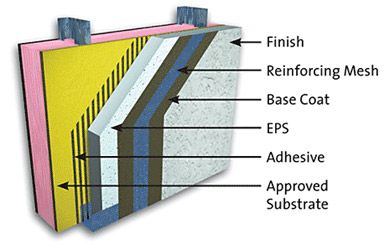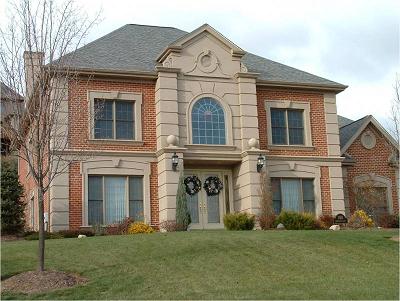Stucco/EFIS Information
What Is EIFS ( Exterior Insulation Finish Systems or Synthetic Stucco)
 Exterior Insulation and Finish Systems (EIFS) are multi-layered exterior wall systems that are used on both commercial buildings and homes. They provide superior energy efficiency and offer much greater design flexibility than other cladding products.
Exterior Insulation and Finish Systems (EIFS) are multi-layered exterior wall systems that are used on both commercial buildings and homes. They provide superior energy efficiency and offer much greater design flexibility than other cladding products.
Developed in Europe in the 1950s, EIFS were introduced in the U.S. almost 30 years ago. They were first used on commercial buildings, and later, on homes. Today, EIFS account for 17% of the U.S. commercial exterior wall market and about 3.5% of the residential wall market. Growth is strong in both sectors, especially in the residential area, where sales are increasing at the rate of 12-18% per year.
EIFS typically consist of the following components:
- insulation board, made of polystyrene or polyisocyanurate foam, which is secured to the exterior wall surface with a specially formulated adhesive and/or mechanical attachment
- a durable, water-resistant base coat, which is applied on top of the insulation and reinforced with fiber glass mesh for added strength
- an attractive and durable finish coat (typically using acrylic co-polymer technology) which is both colorfast and crack-resistant.
Benefits of EIFS
The growing popularity of EIFS is due to the fact that few, if any, competitive materials offer such a wide range of desirable product benefits. Chief among these are superior energy efficiency and virtually unlimited design flexibility.
Energy Efficiency
If you've ever felt the comfort of being wrapped in a warm blanket on a cold winter night, you have some idea of what EIFS can do for a home or building.
EIFS literally wraps the exterior in an energy-efficient thermal blanket. By insulating outside the structure, EIFS reduces air infiltration, stabilizes the interior environment and reduces energy consumption.
By contrast, traditional "between-the-studs" insulation, no matter how thick, leaves "thermal breaks" (gaps where heat and cold pass more freely between the outdoors and the space within) at studs, wall outlets, wall joints, and elsewhere.
In fact, EIFS can reduce air infiltration by as much as 55% compared to standard brick or wood construction. And since walls are one of the greatest areas of heat and air conditioning loss, improvement in the wall insulation can be very meaningful in terms of energy conservation.
What's more, EIFS adds to the "R-value" of a home or building. (R-value is a measurement of the resistance to heat flow; the higher the R-value, the better the material's insulating value.) Most EIFS use insulation board with an R-value of R-4 to R-5.6 per inch as the innermost layer in the wall system. When combined with standard wall cavity insulation, this extra layer can boost wall insulation from R-11 to R-16 or more.
Another point to keep in mind on new construction: Due to the energy efficiency of EIFS, it may be possible to specify lower-capacity heating and air conditioning equipment without sacrificing anything in terms of interior comfort.

Design Flexibility
The rich appearance of EIFS bears a resemblance to stucco or stone, but the systems are far more versatile than these and other materials. Not only do EIFS come in virtually limitless colors and a wide variety of textures, but they also can be fashioned into virtually any shape or design.
With EIFS, skilled applicators can create all sorts of exterior architectural detailing that would often be cost-prohibitive using conventional construction (cornices, arches, columns, keystones, cornerstones, special moldings and decorative accents are but a few examples).
Most of this detailing is computer-generated. The designs are precision-cut out of insulation board, attached to the substrate or wall, then covered with the EIFS base coat, mesh and finish coat.
Using this ingenious process, EIFS applicators can give a striking, distinctive appearance to any building or residence.
Installation
EIFS are definitely not do-it-yourself wall claddings. They should be installed only by experienced applicators who have completed an EIFS manufacturer's training program.
Manufacturers who are members of EIFS Industry Members Association (EIMA) provide extensive specifications for all applicators using their products. EIMA also offers EIFS training manuals and training programs. Interested applicators and home builders are encouraged to contact EIMA or their EIFS distributor to find out more.
To ensure long-term performance of EIFS, EIMA recommends that the following steps be taken on all EIFS jobs:
- Selection of an EIMA member manufacturer who can provide technical support, documented product and system test results, as well as building code compliance information.
- Selection of a knowledgeable, experienced applicator who has current approval of the manufacturer.
- Verification from the manufacturer that the project plans and specs contain sufficient information and details to provide a weather-tight building envelope.
- Verification that all components are supplied and/or approved by one manufacturer.
- A thorough review by the EIFS manufacturer of any unusual project details or conditions before the work commences.
- Verification that the proper materials (with identification and labels intact) were shipped and stored in accordance with the manufacturer's requirements.
- A complete review of the sequencing and scheduling with all subcontractors, prior to the start of the project.
- A review of the scope of the work, project and site conditions, sequencing, and other matters, with the EIFS applicator, prior to the start of the project.
- Examination of the substrate for proper tolerances, cleanliness, etc.
- Periodic inspection of the application of EIFS components to ensure that the manufacturer's recommended procedures are being followed.
Verification that critical related items are being properly installed, especially quality windows and doors, flashing and sealant.
Maintenance & Repair
Unlike wood, stucco and other siding materials, EIFS rarely needs painting. Most EIFS systems are specially formulated with 100% acrylic binder, which gives EIFS superior resistance to fading, chalking and yellowing. As a result, the systems tend to maintain their original appearance over time. And since the color is integral to the finish coat, even if the surface is scratched, the same color appears beneath the abrasion.
EIFS also have excellent resistance to dirt, mildew and mold, which helps keep the building exterior looking clean and freshly painted. Should the surface ever become soiled, it can usually be cleaned by hosing it down.
The systems are designed to be very flexible, which makes them highly crack resistant. When walls expand or contract due to rising or falling temperatures, EIFS are resilient enough to "absorb" building movement and thus avoid the unsightly cracking problems that are so common with stucco, concrete and brick exteriors.
EIFS are among the most water resistant exterior surfaces you can put on a house. But as with all claddings, EIFS must be correctly installed and properly detailed if they are to perform properly. Otherwise, moisture can get behind the systems and cause damage, just as it can with wood siding, brick or any other exterior.
Water intrusion is seldom a problem on commercial structures with EIFS. Water intrusion damage to homes is uncommon, but when it does occur, the moisture typically affects only small areas which can be easily and inexpensively repaired.
In cases where homes have been damaged, the problems have been traced to the use of poor quality (even leaky and/or non code-compliant) windows and/or improper flashing and sealing. As a result, when building with EIFS, it is wise to use quality windows (such as those with AAMA certification) which are code-compliant, and to make sure there is proper flashing and sealing around windows, doors, roofs, deck-to-house attachments, and all other exterior wall penetrations.
Periodic maintenance should include thorough checking of the flashing and sealing to ensure that the building envelope remains watertight. Damaged or missing flashing should be repaired or replaced immediately; likewise, cracked or deteriorated sealant should immediately be repaired, or removed and replaced.
Quality Assurance
T he best way to assure a high quality EIFS job is to rely on members of the EIFS Industry Members Association (EIMA). Founded in 1981, EIMA is a non-profit trade association comprised of 434 of the industry's leading manufacturers, suppliers, distributors and applicators.
EIFS manufactured by EIMA members meet all appropriate building code testing requirements and industry performance standards. Furthermore, each manufacturer conducts their own R&D to ensure optimal component compatibility; for that reason, it is important to specify that the entire system be furnished by a single-source EIMA member manufacturer.
As for installation, it is essential that the system be installed by an experienced applicator who has completed the appropriate training and who follows the proper procedures (mixing coatings as manufacturers recommend, applying coatings at the right thickness, and avoiding conditions that may ultimately affect the performance of EIFS).
How To Identify EIFS or Real Stucco
Stucco - EIFS or Real?
The Real Estate Commission recently determined that the presence of "exterior insulating and finishing system" (EIFS - a type of synthetic stucco) on a property is a material fact and must be disclosed to prospective purchasers. EIFS has been associated with high moisture readings in the structural wood components of properties clad with this product. And high moisture levels often lead to problems such as rot damage and termite infestation. The problem is aggravated by the fact that the damage occurs behind the EIFS siding and can be difficult to detect.
But how do you tell if what appears to be stucco is really EIFS, so that you can make the necessary disclosure?
EIFS is relatively light, and sounds hollow when tapped... Real stucco is relatively heavy and feels and sounds solid when tapped. |
EIFS siding is created by affixing a Styrofoam panel to the wall sheathing. The Styrofoam is covered with reinforcing mesh, followed by a base coat and a finish coat. Both the base and finish coats include an acrylic resin. The resin is water soluble in its liquid form, but once applied and dried, it becomes waterproof.
Typically, EIFS - from Styrofoam to the finished surface - is only about 3/8 of an inch thick. It is relatively light, and sounds hollow when tapped.
The use of EIFS and other products has become increasingly popular in recent years. Because it is easily cut and applied, it is often used for decorative architectural features. In general, the newer the home, the more likely it is to have been sided with EIFS rather than real stucco.
Real stucco, on the other hand, is composed of cement and water, along with inert materials such as sand and lime. Galvanized wire lath may be attached to the exterior of the structure, and the cement mixture applied onto it. Sometimes, the cement mix is applied directly to specially prepared masonry surfaces. It is porous, and not waterproof. Thus, although it will absorb moisture, especially when unpainted, it also will dry easily, without damage to the structure.
Real stucco is relatively heavy and feels and sounds solid when tapped. It is a much harder material than EIFS, and is more resistant to injury by a blow or impact.
EIFS and real stucco may look similar, but a simple comparison of the two quickly reveals their differences. If you are uncertain whether the stucco siding on a property is EIFS, recommend that the parties have it inspected by a qualified inspector. Advise them of the available information about EIFS and other synthetic stucco products and refer them to building inspection offices and other experts for more information.
 Exterior Insulation and Finish Systems (EIFS) are multi-layered exterior wall systems that are used on both commercial buildings and homes. They provide superior energy efficiency and offer much greater design flexibility than other cladding products.
Exterior Insulation and Finish Systems (EIFS) are multi-layered exterior wall systems that are used on both commercial buildings and homes. They provide superior energy efficiency and offer much greater design flexibility than other cladding products. 